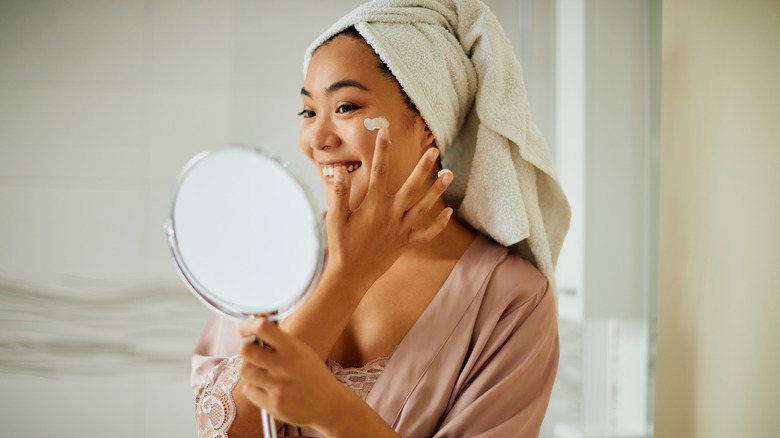Serum Vs. Moisturizer: Which Goes On First?
For some time, when people thought "skincare routine" for their faces, the likely thought of three simple steps: cleanse, tone, moisturize. This three-step process was popularized decades ago and was the central focus of Clinique's skincare marketing for many years (via Clinique). But in recent years, the necessity for other skincare staples like sunscreen became widely accepted, and so a fourth product was added to many morning routines. Lately, however, skin serums for every possible concern from aging to dryness to discoloration have taken the market by storm.
Serums tend to offer a more powerful, more concentrated dose of active ingredients than creams or lotions, and so their increasing popularity makes sense (via Healthline). The purpose of a serum, no matter its specific formulation, is to allow more molecules of active ingredients to penetrate the skin's surface than generally happens with other products. Therefore, people tend to see results more quickly from serums than other products.
But adding another step or two to your skincare routine can get overwhelming and confusing, and figuring out the correct order in which to apply them for best results can feel challenging. Luckily, there is a rule (and an exception) to follow to help make the process a breeze.
The proper order to apply skincare
According to Cosmopolitan, the bible for all things beauty, the general rule for applying skincare products is to start with the lightest and end with the heaviest, as thinner products cannot absorb through thicker ones. For a daytime routine that contains multiple products, that order might look like this: cleanser, toner, serums, eye cream, spot treatments, moisturizer, face oil, sunscreen. At night, since you are less likely to be using a sunscreen and more likely to be using an anti-aging product like a retinol, that routine might look like this: cleanser, toner, serums, eye cream, spot treatments, moisturizer, retinol, face oil.
Now, depending on the product and brand, you might be using a moisturizer that contains retinol rather than a separate retinol product, or you might mix a face oil with a lightweight water-based gel to create a moisturizer, so don't get too caught up in this list as the holy grail. Instead, just follow the rule of lightest to heaviest, and you should be getting the best results from each product without creating irritation or skin barrier issues.
Of course, like many rules you learned in grammar class, there are often exceptions.
The exception to the rule
Dermatologist Hadley King spoke to Mind Body Green about this exact topic. While she agrees that the golden rule is that moisturizer should always go after serums "because moisturizers contain some occlusive ingredients, which help them trap moisture in the skin but prevent other ingredients from penetrating," she does acknowledge that there is one exception to this rule.
In the event that "you want to decrease the potency of a serum—like if it contains potentially irritating ingredients like retinol or salicylic acid, then applying a moisturizer first could help make the serum less potent and less irritating," King says. So if you are in the beginning phases of trying out a new, intense serum, then starting out this way to see how your skin reacts before using it full-force can help you get a gage on what your skin can handle. Eventually, you could work up to using the serum full strength if your skin tolerates the diluted version.
Happy layering!


